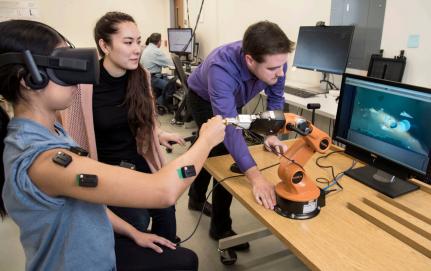Information about the Neuroscience of Dance in Health and Disability Laboratory.
 The Neuroscience of Dance in Health and Disability Laboratory focuses on research to understand how the human brain generates motor coordination using the language of dance movement. The inquiry into basic science questions informs our research on the design of dance/movement training protocols in health, disability, and rehabilitation through the life span.
The Neuroscience of Dance in Health and Disability Laboratory focuses on research to understand how the human brain generates motor coordination using the language of dance movement. The inquiry into basic science questions informs our research on the design of dance/movement training protocols in health, disability, and rehabilitation through the life span.
Our research is interdisciplinary and involves the areas of dance, biomechanics, mathematical modeling, motor control, motor learning, physics, body-environment interfaces, mixed media, computational neuroscience, neurophysiology, and rehabilitation. Students in our laboratory have the opportunity to grow intellectually by immersion in quantitative research on the intersection of the arts and sciences. The Neuroscience of Dance in Health and Disability Laboratory offers research opportunities for undergraduate and graduate students at the University of Illinois at Urbana-Champaign.
Our Principal Investigator is Dr. Citlali Lopez-Ortiz, PhD, MA.
Check out the tabs below or our website here to learn more or to get involved.
Cerebral Palsy
Movement Characterization in Cerebral Palsy
Through the integration of classical ballet exercises with virtual reality and haptic environments, this project aims to characterize the movement in children with cerebral palsy.
Targeted Ballet Class for Children and Adults with Cerebral Palsy
Examining muscle regulation adaptations in response to classical ballet training in children and adults with cerebral palsy.
Other Neural Diseases
Mindful Ballet Class for Adults with Multiple Sclerosis
A combination of mindfulness training and classical ballet targeted to adults diagnosed with multiple sclerosis seeks to improve gait function and balance while ameliorating ataxia.
Training Eye Movements in Parkinson's Disease
Investigation of eye movement response to training protocols in subjects with and without Parkinson's disease